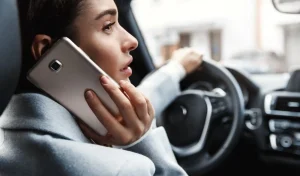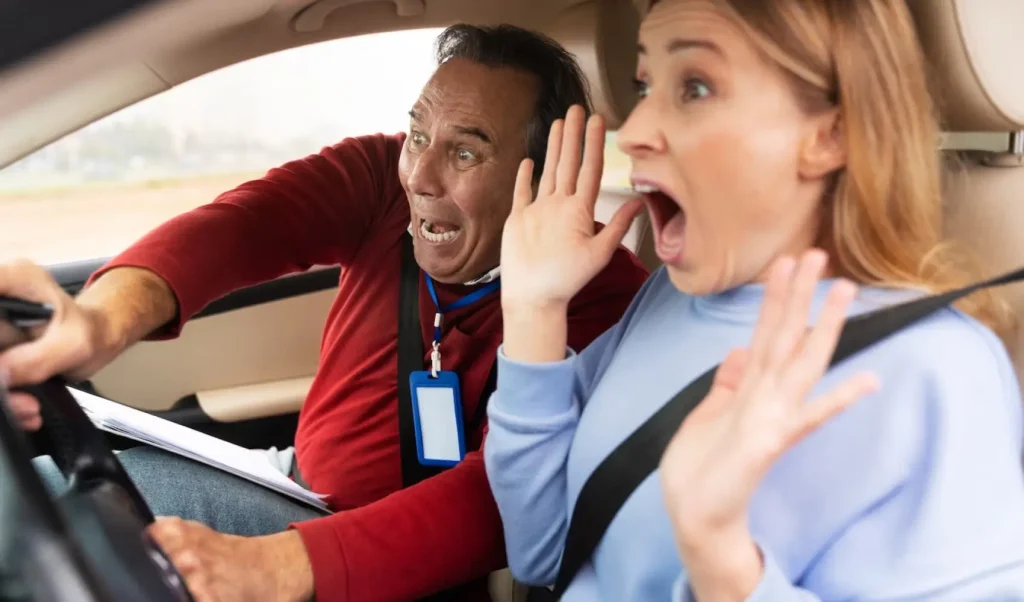
Distracted driving can be defined as any activity that diverts a driver’s attention away from the primary task of driving. These distractions can significantly impair a driver’s ability to react to road conditions, increasing the risk of accidents. To better understand this issue, let’s break down the types of distractions that drivers face.
Distracted driving is an alarming and widespread issue that continues to pose a significant threat to road safety. In this article, we’ll delve into the various aspects of distracted driving, exploring its definition, types, the common activities associated with it, the dangers it presents, and the eye-opening statistics that highlight its severity.

Types of Distracted Driving
Visual Distractions
Visual distractions occur when a driver takes their eyes off the road. This can include looking at a text message, reading a map, or even admiring the scenery. Even a momentary diversion of the eyes can have dire consequences.
Manual Distractions
Manual distractions involve actions that require a driver to take their hands off the steering wheel. Examples include eating, drinking, adjusting the radio, or reaching for items in the backseat. These seemingly harmless actions can lead to dangerous situations.
Cognitive Distractions
Cognitive distractions occur when a driver’s mind wanders away from the task of driving. Daydreaming, engaging in deep conversations, or thinking about personal problems are all forms of cognitive distractions. Such distractions can impair a driver’s decision-making abilities.
Proudly Serving Duluth and All of Georgia Contact us to start your recovery! Explore Our Practice Areas

Common Distracted Driving Activities
Texting and Smartphone Use
One of the most notorious forms of distracted driving is texting or using a smartphone while driving. The allure of instant communication can be irresistible, but it significantly increases the risk of accidents.
Eating and Drinking
Many people engage in eating and drinking while behind the wheel, considering it a time-saving practice. However, juggling a burger and a soda can divert a driver’s attention, often with disastrous consequences.
Adjusting the Radio or GPS
Even adjusting the radio station or programming a GPS device can take a driver’s focus away from the road. It only takes a few seconds of distraction for an accident to occur.

The Dangers of Distraction While Driving
The dangers associated with distracted driving are real and far-reaching. Research has shown that engaging in distracted driving activities dramatically increases the likelihood of accidents.
Increased Accident Risk
Drivers who text while driving are six times more likely to be involved in an accident. The combination of visual, manual, and cognitive distractions makes texting particularly hazardous.
Impact on Reaction Time
Distracted driving impairs a driver’s reaction time. When a sudden hazard arises, a distracted driver may not be able to respond in time to prevent a collision.
Legal Consequences
Beyond the immediate danger, there are legal consequences to consider. Many jurisdictions have strict laws against distracted driving, and violators can face fines, license suspensions, or even jail time.
Click to contact our personal injury lawyers today

Crash Statistics on Distracted Driving
To fully grasp the extent of the problem, let’s delve into some eye-opening statistics related to distracted driving.
Accident Rates
Each day in the United States, approximately nine people die, and over a thousand are injured in accidents involving distracted drivers. These accidents are entirely preventable.
Demographics
While people of all ages engage in distracted driving, young adults and teenagers are particularly prone to it. The use of smartphones and the allure of constant connectivity contribute to this trend.

Complete a Free Case Evaluation form now
Statistics of People Who Died in Crashes Involving Cellphone Use
In 2023, the statistics of people who died in crashes involving cell phone use in the United States were alarming. According to reports, there were a total of 2,256 fatalities directly linked to cell phone use while driving. This represents a significant increase compared to 2021 and 2022.
The rise in cellphone-related fatalities can be attributed to the widespread use of smartphones and the growing addiction to technology. It is crucial to emphasize the importance of safe driving habits and the dangers of driver distraction. Efforts should be made to raise awareness about the risks associated with cellphone use while operating a motor vehicle and encourage responsible behavior on the roads to prevent further loss of lives.
Why Do People Engage in Distracted Driving?
- Overconfidence: Some drivers believe they can multitask safely.
- Addiction to Technology: The constant need to stay connected can be addictive.
- Complacency: Drivers may become complacent if they haven’t experienced accidents in the past.

Distracted Driving Awareness Month
Distracted Driving Awareness Month is observed in the United States every April. It is an initiative to raise awareness about the dangers of distracted driving and encourage drivers to practice safe habits on the road. Distracted driving refers to any activity that diverts attention away from driving, such as texting, talking on the phone, eating, or using in-vehicle technologies.
This awareness campaign aims to educate the public on the risks and consequences associated with distractions while driving, which can lead to accidents, injuries, and even fatalities. By highlighting the importance of focusing solely on the task of driving, Distracted Driving Awareness Month aims to promote responsible behavior among drivers and reduce the number of accidents caused by distractions.
NHTSA Campaign: U Text. U Pay. U Drive
The National Highway Traffic Safety Administration (NHTSA) has launched a campaign called “U Text. U Pay. U Drive” in an effort to combat distracted driving. The aim of the campaign is to raise awareness about the dangers of using a cell phone while driving.
According to statistics, sending or receiving a text takes a driver’s eyes off the road for an average of 4.6 seconds, which is equivalent to driving the length of an entire football field at 55 mph without looking.
The campaign includes a series of advertisements, social media campaigns, and increased law enforcement efforts targeting distracted drivers. The NHTSA hopes that through this campaign, drivers will realize the importance of staying focused on the road and will avoid texting while driving.
Conclusion
In conclusion, distracted driving poses a significant threat to road safety. It encompasses a wide range of activities that divert a driver’s attention, leading to an increased risk of accidents. To combat this issue, it’s essential to raise awareness, enforce laws, and leverage technology to promote safer driving habits.
Frequently Asked Questions (FAQs)
Q1: What are the most common forms of distracted driving?
The most common forms of distracted driving include activities like texting or using a smartphone, eating and drinking, adjusting the radio or GPS, and talking to passengers. Anything that diverts your attention from driving is a distraction.
Q2: How can I avoid the temptation of using my phone while driving?
To resist the temptation of using your phone while driving, you can silence or put it in a place where it’s out of reach. Consider using apps that automatically disable notifications when you’re driving. Remember, safety should always come first.
Q3: Are there apps that can help prevent distracted driving?
Yes, there are various apps designed to prevent distracted driving. These apps can block incoming texts and calls while you’re on the road, providing a safer driving experience. Some also track your driving behavior and offer rewards for safe habits. It’s a proactive way to combat distractions.
Q4: What should I do if I witness someone driving while distracted?
If you witness someone driving while distracted, consider reporting it to the authorities if it’s safe to do so.
Q5: Can distracted driving lead to legal consequences?
Yes, distracted driving can lead to legal consequences such as fines, license suspension, or even jail time in some cases.
Call or text 404-951-3513 or complete a Free Case Evaluation form









